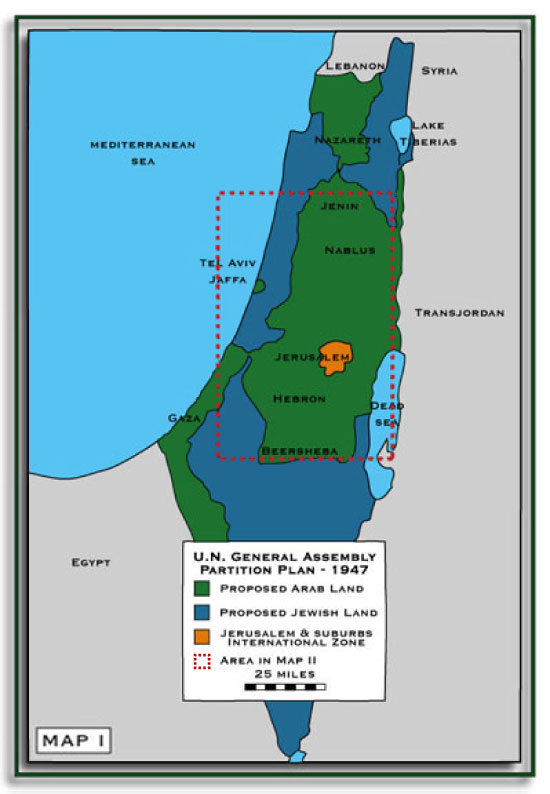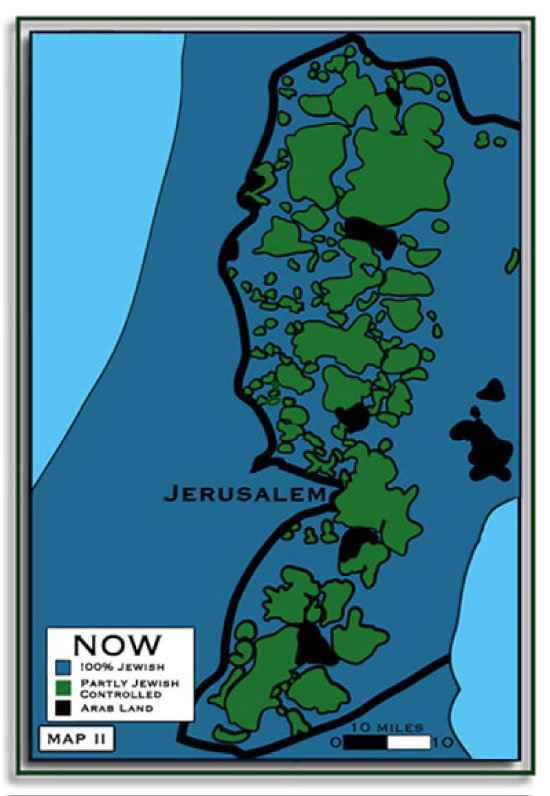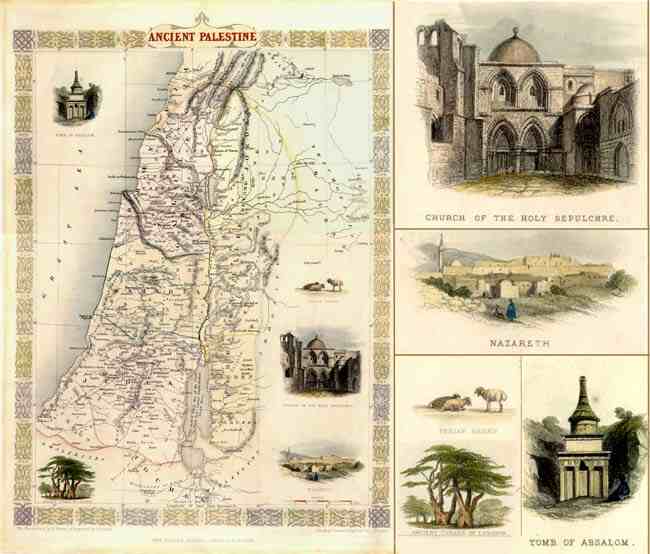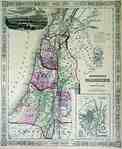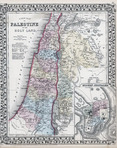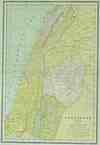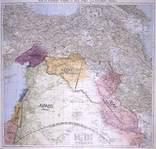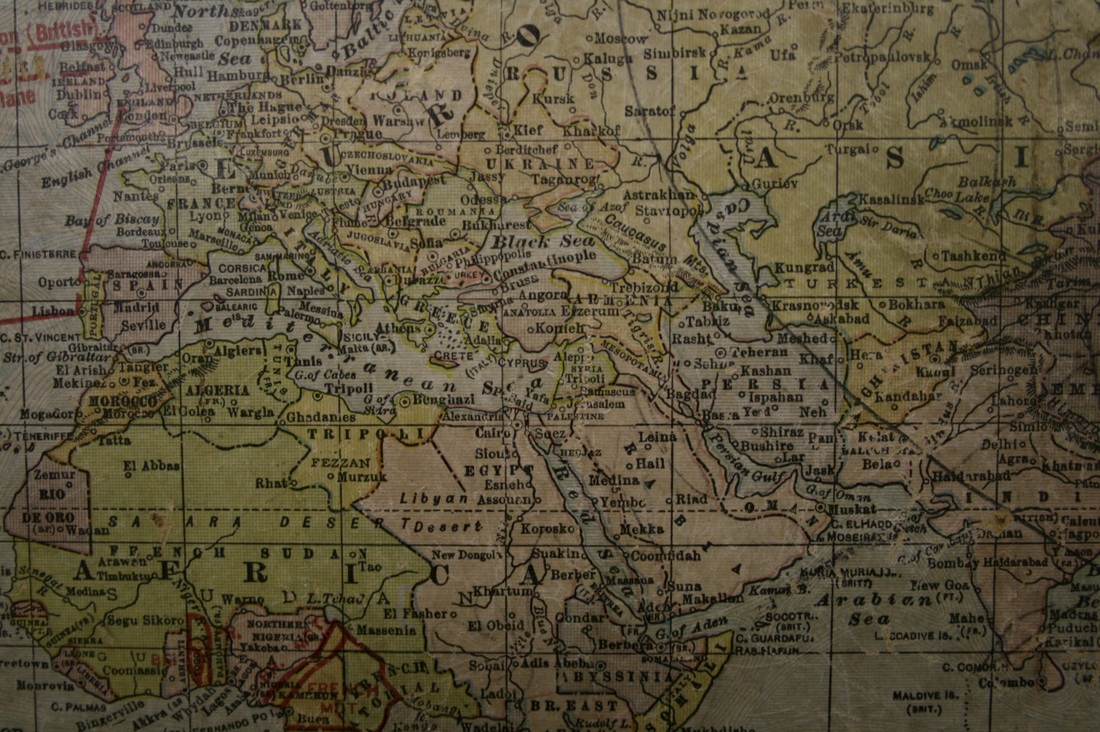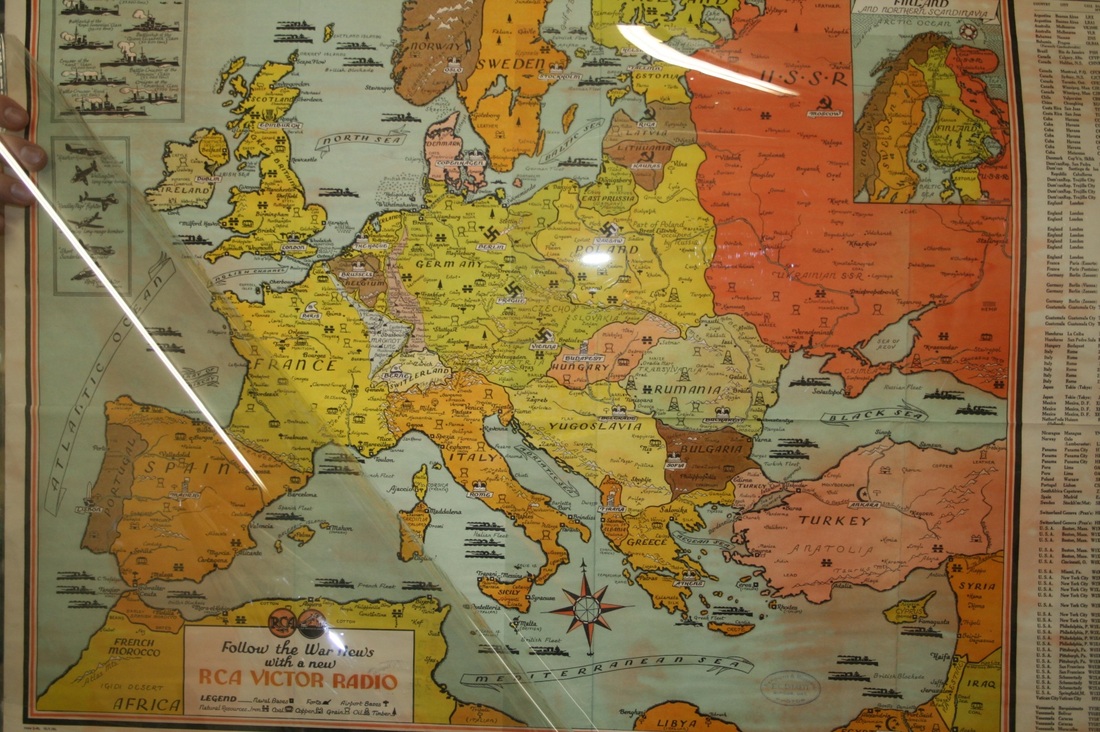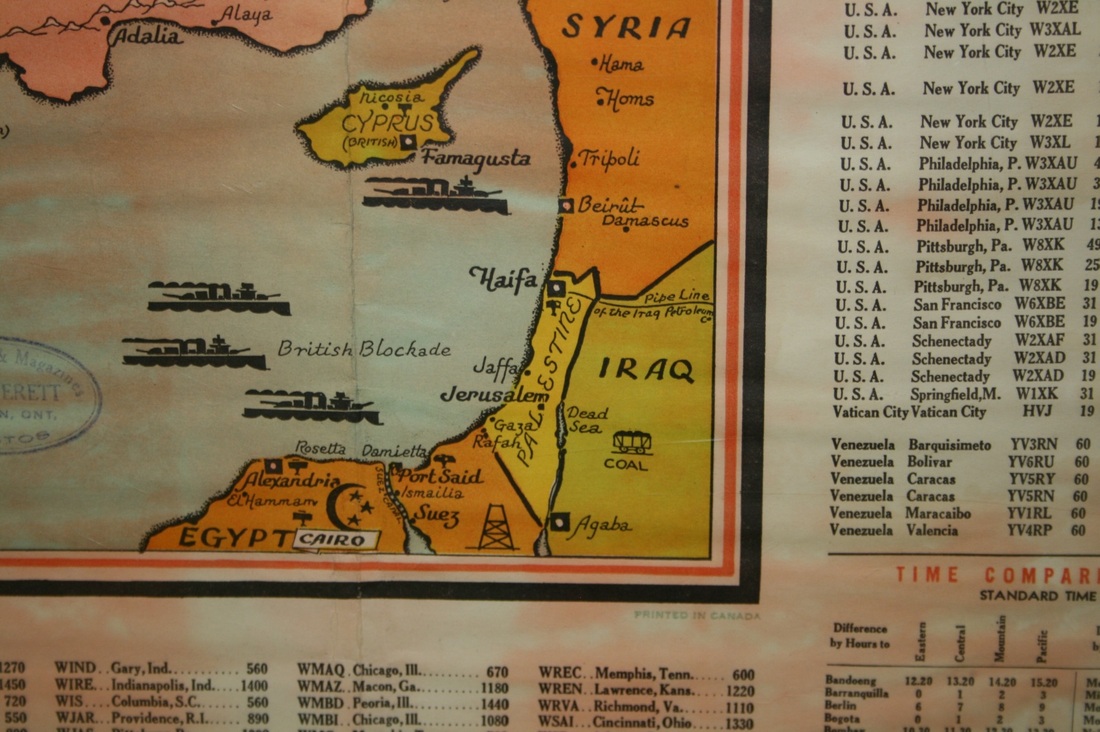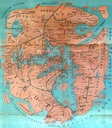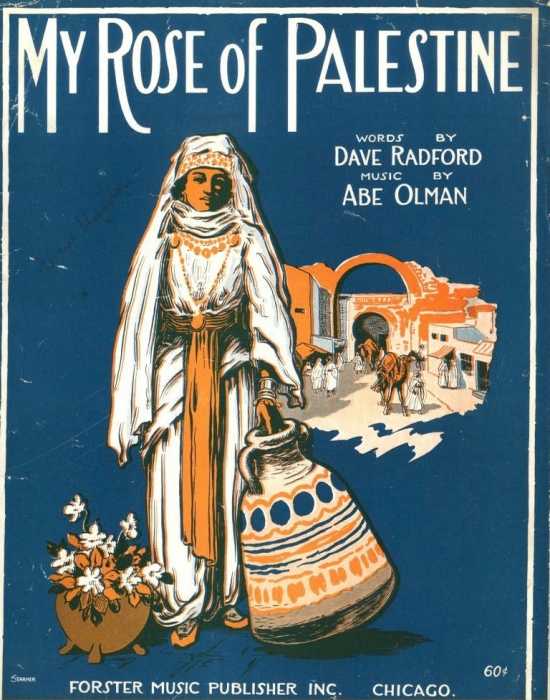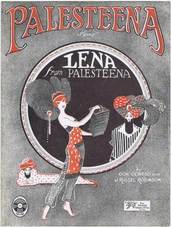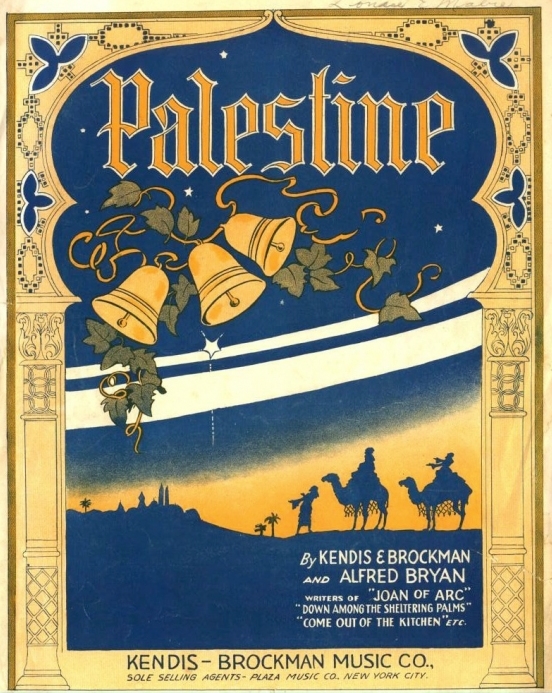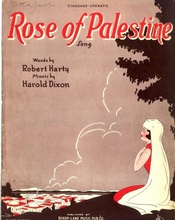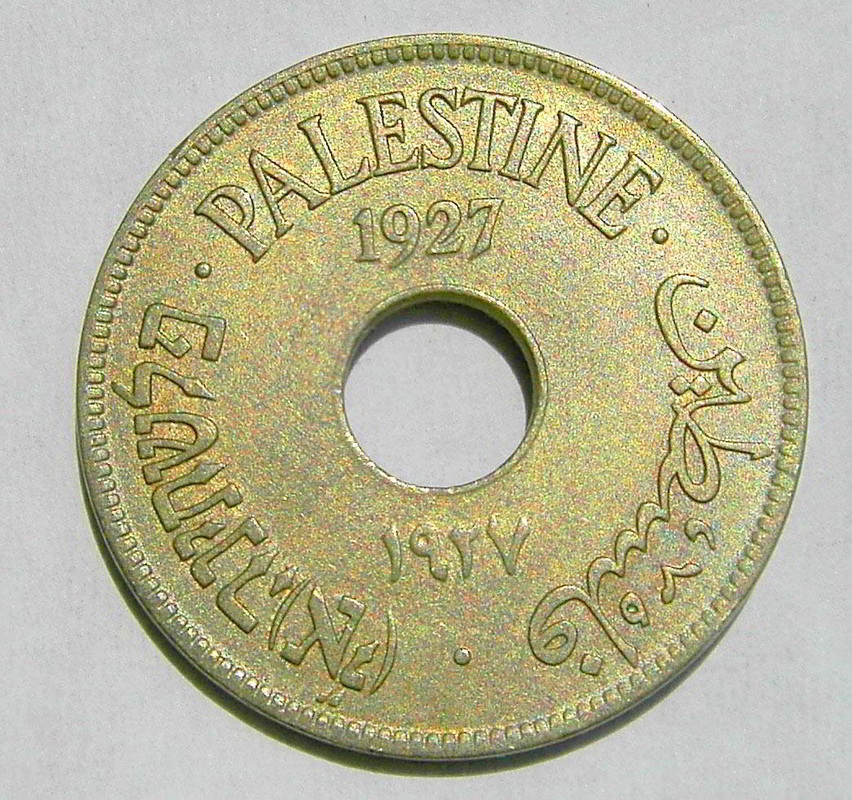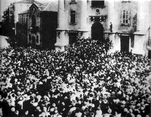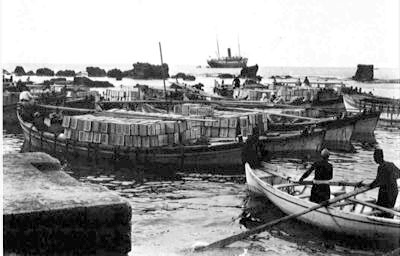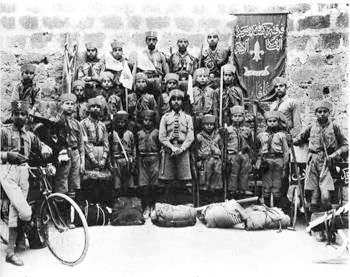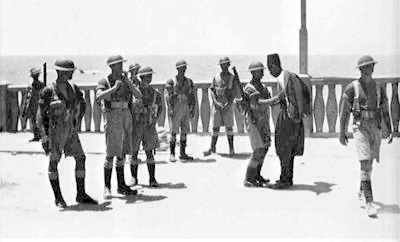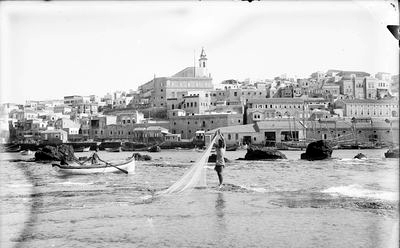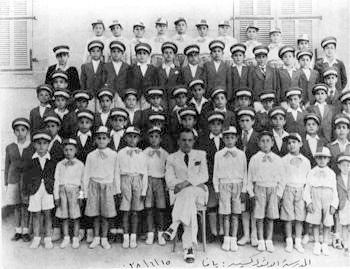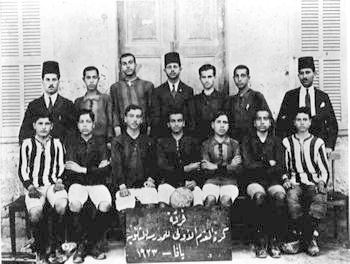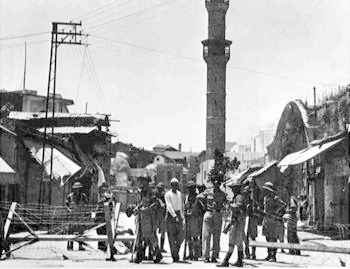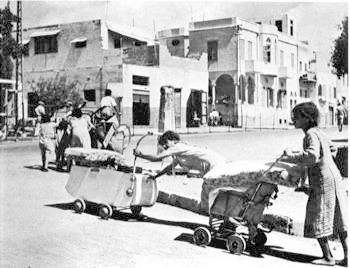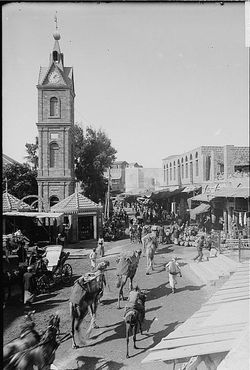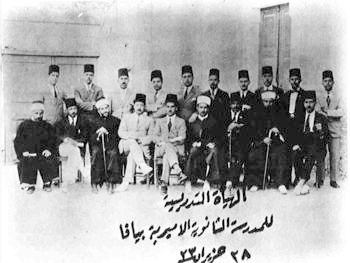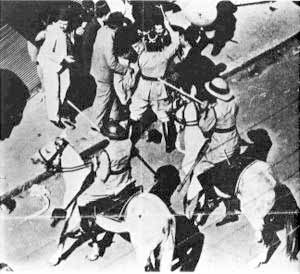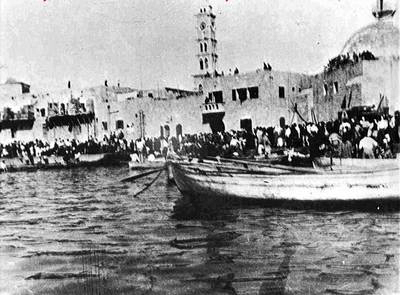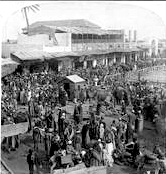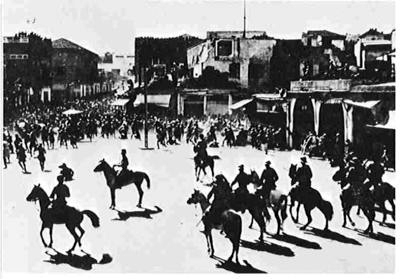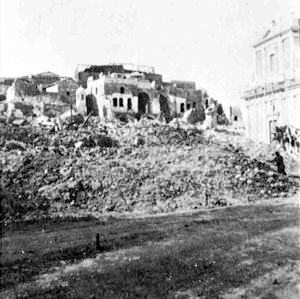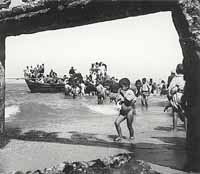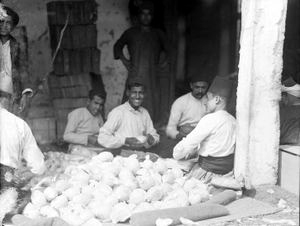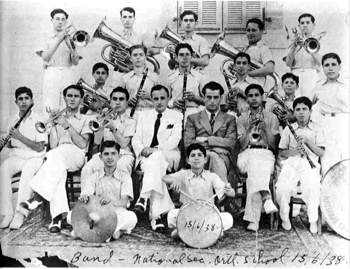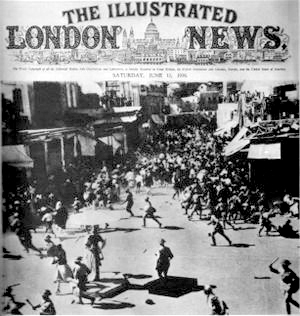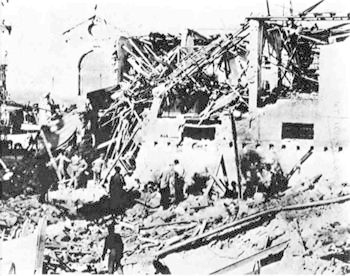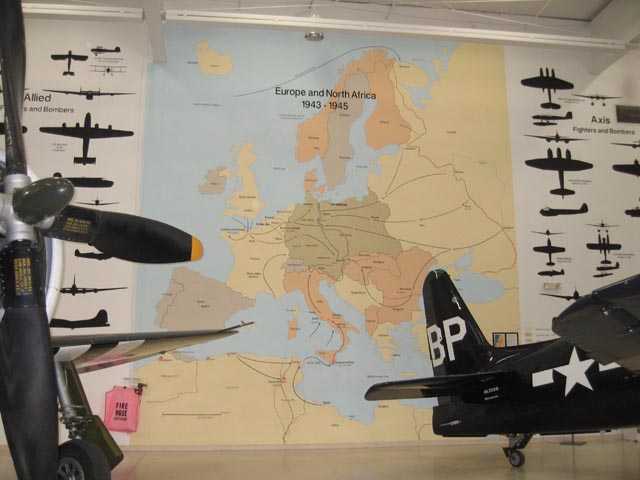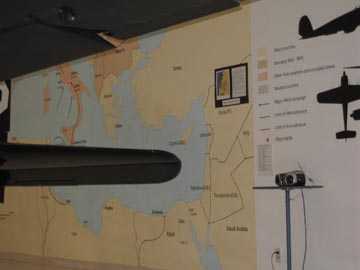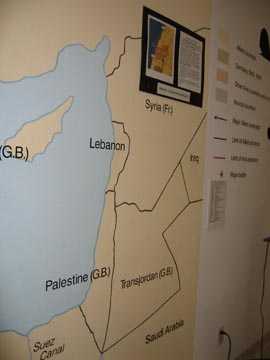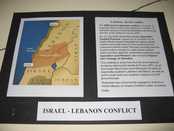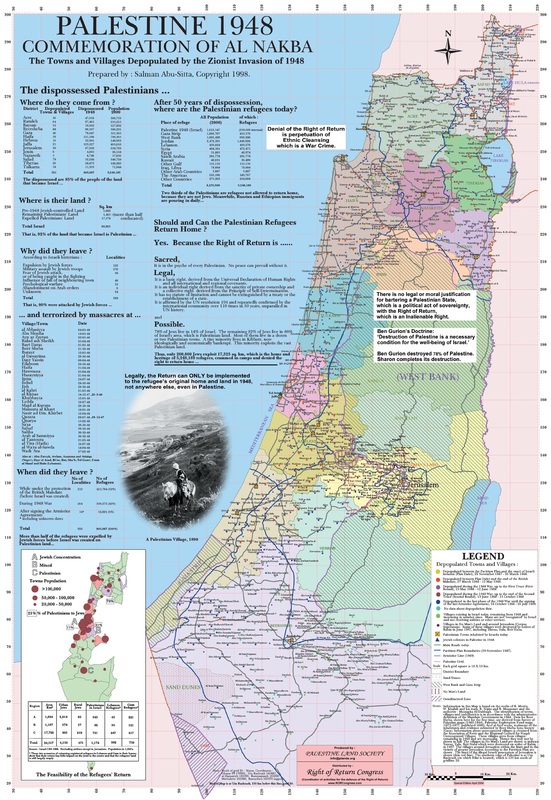Perhaps the earliest sound footage of Jerusalem filmed from November 9-19, 1929. These scenes were taken with early Movietone sound cameras. (video removed from youtube by Israel)(another video 1929)
This footage is very raw but it captures all sorts of city atmosphere.
In the first section they seem to be documenting landmarks in Jerusalem for English and French audiences. As always the casual passerbys are the real star of the show.
Condensed/worked on footage and sound 0:07 - A tour of various locations 10:43 - Some locals talk to the cameras 13:26 - Street markets/cattle dealers 18:08 - Religious ceremonies (video Jerusalem 1910) (video Jaffa Gate Jerusalem 1897)
This footage is very raw but it captures all sorts of city atmosphere.
In the first section they seem to be documenting landmarks in Jerusalem for English and French audiences. As always the casual passerbys are the real star of the show.
Condensed/worked on footage and sound 0:07 - A tour of various locations 10:43 - Some locals talk to the cameras 13:26 - Street markets/cattle dealers 18:08 - Religious ceremonies (video Jerusalem 1910) (video Jaffa Gate Jerusalem 1897)
|
The above map is Israel as it was first created by UN declaration in 1947. The blue portion is Israel, the rest is all Arab lands. Note that Jerusalem was completely within Arab lands and Israel was much smaller than it is today. Note also that there is NO Israeli presence inside the area surrounding Jerusalem. No settlements, certainly no IDF. The red square outlines the approximate region shown in the map to the right.
|
This is Israel as it is today. Note that the western border of Palestine has been pushed up to Jerusalem. Such a land grab is NOT the result of a defensive act, but of an invasion to bring Jerusalem under Israeli control, even though Jerusalem was not originally part of Israel. The maps clearly tell the story of an Israel conquering lands which do not belong to it. Since Sharon took office, Israel has built more illegal Jewish Settlements on Palestinian land. Note on the above map that the majority of the lands which were originally Arab lands when Israel was created, are now under complete (dark blue) or partial (green) Israeli control. Only the black areas remain to the Palestinians, and those are shrinking by the minute.
|
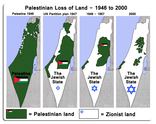
How does a defensive action result in the total conquest of someone else's lands?
The answer is that it does not. Israel is the aggressor. The maps of Israel then and now prove it. 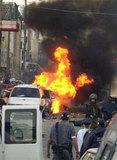
Stop buying into what Sharon claims Israel "has to do" and look at what Israel has actually done. The maps tell the story of a nation eager to conquer lands which do not belong to it. Israel has invaded virtually every nation it shares borders with, including Syria and Lebanon, and as the map above shows has almost conquered Palestine and is ready to "ethnically cleanse" the region. Far from being the poor victimized society desperately defending itself Israel likes to pretend it is in order to wrest more money from Americans, Israel is in fact the most militarily aggressive nation in the region.
Israel has ALWAYS portrayed non-Israelis as animals, in order to make it easier for the American tax payers who pay for the weapons accept their killing. And Israel has always resorted to staged terror bombings to further its agenda, such as the Lavon affair and more recently when a supposed suicide bomber turned out to be a known Israeli collaborator. In one recent case photos showed that what was reported as a suicide bomb in Jerusalem was actually a car bomb. Even now, the Israeli media admits that nobody (other than the purported bomber) was actually hurt in this latest bombing. Now, would a real anti-Israel suicide bomber, obviously able to select where and when the bomb is to go off, really choose to detonate the bomb when there is nobody around, damaging ONLY buildings? So, if you are being lied to about the Jerusalem bombings, and with Israel's past use of, indeed PRIDE of, deception as a tool to be used against friend and enemy alike, it's time to take another hard look at the fact that every other nation on Earth except the United States is opposed to what Israel is doing. You know, if the United States REALLY wanted peace in Palestine, all they have to do is stop signing the checks that pay for Israel's war machine. "Every time we do something you tell me America will do this and will do that . . . I want to tell you something very clear: Don't worry about American pressure on Israel. We, the Jewish people, control America, and the Americans know it." -- Israeli Prime Minister, Ariel Sharon, October 3, 2001. HISTORICAL PALESTINE Another claim that Israel likes to make is that Palestine never really existed to start with. "How can we return the occupied territories? There is nobody to return them to." Golda Maier, March 8, 1969. "There was no such thing as Palestinians, they never existed." Golda Maier Israeli Prime Minister June 15, 1969 Oh? The people shall hear, and be afraid: sorrow shall take hold on the inhabitants of Palestina. -- Exodus 15:14 |
Rejoice not thou, whole Palestina, because the rod of him that smote thee is broken : for out of the serpent's root shall come forth a cockatrice, and his fruit shall be a fiery flying serpent. -- Isaiah 14:29
Howl , O gate; cry , O city; thou, whole Palestina, art dissolved : for there shall come from the north a smoke, and none shall be alone in his appointed times. -- Isaiah 14:31
Yea, and what have ye to do with me, O Tyre, and Zidon, and all the coasts of Palestine? will ye render me a recompence? and if ye recompense me, swiftly and speedily will Ireturn your recompence upon your own head; -- Joel 3:4
And again, the maps tell a different story.
Howl , O gate; cry , O city; thou, whole Palestina, art dissolved : for there shall come from the north a smoke, and none shall be alone in his appointed times. -- Isaiah 14:31
Yea, and what have ye to do with me, O Tyre, and Zidon, and all the coasts of Palestine? will ye render me a recompence? and if ye recompense me, swiftly and speedily will Ireturn your recompence upon your own head; -- Joel 3:4
And again, the maps tell a different story.
|
|
UPDATE: YouTube removed the original video, which is simply a recitation of the below text, due to "Terms of Service" violations. The video is a mirror, although of poorer quality.
One can imagine who complained and why! The video can also be watched or downloaded here. The following is by Nima Shirazi Specific references to "Palestine" date back nearly five hundred years before "the time of Jesus." In the 5th Century BCE, Herodotus, the first historian in Western civilization, referenced "Palestine" numerous times in chronicle of the ancient world, The Histories, including the following passage describing "Syrians of Palestine": |
"...they live in the coastal parts of Syria; and that region of Syria and all that lies between it and Egypt is called Palestine." (VII.89) The above translation by Harry Carter is featured in the 1958 Heritage Press edition of Herodotus' famous work. Both older and newer versions corroborate the accuracy of the reference. A. D. Godley's 1920 translation of the crucial line states, "This part of Syria as far as Egypt is all called Palestine", while Robin Waterfield's 1998 updated Oxford translationrenders the passage this way: "This part of Syria, all the way to the border with Egypt, is known as Palestine."
A hundred years later, in the mid-4th Century BCE, Aristotle made reference to the Dead Sea in his Meteorology. "Again if, as is fabled, there is a lake in Palestine, such that if you bind a man or beast and throw it in it floats and does not sink, this would bear out what we have said," he wrote. "They say that this lake is so bitter and salt that no fish live in it and that if you soak clothes in it and shake them it cleans them." (II.3)
Two hundred years later, in the mid-2nd Century BCE, ancient geographer Polemon wroteof a place "not far from Arabia in the part of Syria called Palestine," while Greek travel writer Pausanias wrote in his Description of Greece, "In front of the sanctuary grow palm-trees, the fruit of which, though not wholly edible like the dates of Palestine, yet are riper than those of Ionia." (9.19.8)
Despite the Zionists’ claim "the Romans didn't rename Judea as 'Palestina' until a hundred years after the death of Jesus," contemporaries of Jesus also routinely referred to Palestine as, well, Palestine. For instance, in the first decade of the 1st Century, the Roman poet Ovid mentioned Palestine in both his famed mythological poem Metamorphoses and his erotic elegy The Art of Love. He also wroteof "the waters of Palestine" in his calendrical poem Fasti. Around the same time, another Latin poet Tibullus wroteof "the crowded cities of Palestine" in a section "Messalla’s Triumph" in his poem Delia.
The noted Alexandrian Jewish philosopher Philo, writing around the 1stCentury CE, opined, "Also Syria in Palestine, which is occupied by no small part of the very populous nation of the Jews, is not unproductive of honourable virtue." (XII.75)
The Jewish historian Josephus (c.37-100 CE) was born and raised in Jerusalem, a military commander in Galilee during the First Jewish Revolt against the occupying Roman authority, acted as negotiator during the Siege of Jerusalem in 70 CE and later penned vital volumes of Levantine Jewish history. His The Jewish War, Antiquities of the Jews, and Against Apion all contain copious references to Palestine and Palestinians. Towards the end of Antiquities, Josephus writes, "I shall now, therefore, make an end here of my Antiquities; after the conclusion of which events, I began to write that account of the war; and these Antiquities contain what hath been delivered down to us from the original creation of man, until the twelfth year of the reign of Nero, as to what hath befallen the Jews, as well in Egypt as in Syria and in Palestine, and what we have suffered from the Assyrians and Babylonians, and what afflictions the Persians and Macedonians, and after them the Romans, have brought upon us; for I think I may say that I have composed this history with sufficient accuracy in all things." (XX.11.2)
The claim that the Roman emperor Hadrian, eager to punish Jewish inhabitants of Judea after the Bar Kokhba Revolt, officially changed the name of the region to "Syria Palaestina" or simply "Palestine" in 135 CE and forced the Jewish community into exile is dubious at best, especially when, by then, the terms "Syrian Palestine" and "Palestine" had already been in use for over six hundred years.
A hundred years later, in the mid-4th Century BCE, Aristotle made reference to the Dead Sea in his Meteorology. "Again if, as is fabled, there is a lake in Palestine, such that if you bind a man or beast and throw it in it floats and does not sink, this would bear out what we have said," he wrote. "They say that this lake is so bitter and salt that no fish live in it and that if you soak clothes in it and shake them it cleans them." (II.3)
Two hundred years later, in the mid-2nd Century BCE, ancient geographer Polemon wroteof a place "not far from Arabia in the part of Syria called Palestine," while Greek travel writer Pausanias wrote in his Description of Greece, "In front of the sanctuary grow palm-trees, the fruit of which, though not wholly edible like the dates of Palestine, yet are riper than those of Ionia." (9.19.8)
Despite the Zionists’ claim "the Romans didn't rename Judea as 'Palestina' until a hundred years after the death of Jesus," contemporaries of Jesus also routinely referred to Palestine as, well, Palestine. For instance, in the first decade of the 1st Century, the Roman poet Ovid mentioned Palestine in both his famed mythological poem Metamorphoses and his erotic elegy The Art of Love. He also wroteof "the waters of Palestine" in his calendrical poem Fasti. Around the same time, another Latin poet Tibullus wroteof "the crowded cities of Palestine" in a section "Messalla’s Triumph" in his poem Delia.
The noted Alexandrian Jewish philosopher Philo, writing around the 1stCentury CE, opined, "Also Syria in Palestine, which is occupied by no small part of the very populous nation of the Jews, is not unproductive of honourable virtue." (XII.75)
The Jewish historian Josephus (c.37-100 CE) was born and raised in Jerusalem, a military commander in Galilee during the First Jewish Revolt against the occupying Roman authority, acted as negotiator during the Siege of Jerusalem in 70 CE and later penned vital volumes of Levantine Jewish history. His The Jewish War, Antiquities of the Jews, and Against Apion all contain copious references to Palestine and Palestinians. Towards the end of Antiquities, Josephus writes, "I shall now, therefore, make an end here of my Antiquities; after the conclusion of which events, I began to write that account of the war; and these Antiquities contain what hath been delivered down to us from the original creation of man, until the twelfth year of the reign of Nero, as to what hath befallen the Jews, as well in Egypt as in Syria and in Palestine, and what we have suffered from the Assyrians and Babylonians, and what afflictions the Persians and Macedonians, and after them the Romans, have brought upon us; for I think I may say that I have composed this history with sufficient accuracy in all things." (XX.11.2)
The claim that the Roman emperor Hadrian, eager to punish Jewish inhabitants of Judea after the Bar Kokhba Revolt, officially changed the name of the region to "Syria Palaestina" or simply "Palestine" in 135 CE and forced the Jewish community into exile is dubious at best, especially when, by then, the terms "Syrian Palestine" and "Palestine" had already been in use for over six hundred years.
|
|
Lumière brothers' film of Palestine shot in 1896!
|
|
Sheet Music cover from 1917.
|
Sheet Music cover from the 1920s.
|
Sheet Music cover from the 1920s.
|
Sheet Music cover from 1922.
Eddie Cantor sings the above (mp3) |
Palestine coin
|
See also " Descriptive Geography and Brief Historical Sketch of Palestine by Rabbi Joseph Schwarz, 1850"
|
Jaffa, Palestine: Palestinians gather at the Grand Serai (local government offices) in July 1908, to celebrate the al-Hurriyah Revolution (i.e. the Young Turks Revolution) against Sultan Abdul Hamid and in favor of the restoration of the constitution and the holding of Parliamentary elections. (via Walid Khalidi, Before Their Diaspora).
Jaffa, Palestine: Boxed Jaffa oranges being loaded for export, early 1920's. Jaffa oranges were Palestine's leading export. After 1948, Jaffa's nationalized orange groves and the established markets for their products provided the major source of income for the new state of Israel.
Jaffa, Palestine: Wolf Cubs and Boy Scouts with camping gear, at the Government Secondary Boys' School, 1924.
Jaffa, Palestine: British soldiers search one of Jaffa's residents during the Arab Revolt, 1936
Jaffa, Palestine: The ruins of the Manshiyeh quarter, after indiscriminate bombardment by the Irgun.
Jaffa, Israel: Jewish refugees from Europe are resettled in ethnically-cleansed Jaffa, 1949.
|
Jaffa, Palestine: General view of the city from the sea looking east, pre-1914. (Matson Collection, 1898-1914).
Jaffa, Palestine: Harvesting the oranges. (Matson Collection)
Jaffa, Palestine: Elementary school pupils at the National Christian Orthodox School (1938).
Jaffa, Palestine: The Government Secondary Boys' School first XI (Soccer) in 1923.
The Punishment of Jaffa, Palestine: British soldiers cordon off Jaffa's old city in preparation for the punitive demolition of Palestinian buildings in reprisal for the Arab Revolt against British policy in Palestine; 1936.
Jaffa, Palestine: Palestinian residents salvage whatever possessions they can carry as they flee the city. (via Walid Khalidi, Before Their Diaspora)
video 1940 |
Jaffa, Palestine: Street scene in the old city next to the Jaffa's famous Clock tower, pre-1914 (Matson Collection).
Jaffa, Palestine: The staff of the Government Secondary Boys' School (al-Ameiryah High School) in 1923. Seated center is Salim Katul, author of a series of textbooks in Arabic on the natural sciences.
Jaffa, Palestine: British Soldiers clubbing Palestinian dignitary Musa Kazim Pasha al-Husseini at the 27 October 1933 demonstration against British policy on Zionist immigration into Palestine.
Musa Kazim Pasha al-Husseini died six months later, 27 March 1934, at the age of eighty-one, having never recovered from the effects of this beating. (via Walid Khalidi, Before Their Diaspora). Jaffa, Palestine: Palestinians driven into the sea at Jaffa Harbor, late April 1948.
With the land routes cut off by the Haganah, tens of thousands of the citizens of Jaffa and neighboring villages fled by boat: south to Gaza and Egypt, and north to Lebanon. (via Walid Khalidi, Before Their Diaspora) |
Jaffa, Palestine: The bazaar in 1896.
Video 1878+ Jaffa, Palestine: Sorting and packing citrus fruits, 1920's.
Jaffa, Palestine: Carpentry class at the Government Secondary Boys' School, 1924. The inscription over the door reads, "The least worthy of you are the least learned".
Jaffa, Palestine: Palestinians demonstrate in Jaffa's central square against the plans of the British government to increase Zionist immigration into Palestine, 27 October 1933.
The Punishment of Jaffa, Palestine: British soldiers carry out punitive demolitions in the old city, in reprisal for the Arab Revolt against British policy in Palestine; 1936.
Video 1936 Jaffa Harbor, Palestine: Palestinian refugees flee Jaffa by boat for Gaza, Apr-May 1948. By the time Jaffa finally fell on 13 May 1948, fewer than 4,000 of its 70,000 residents remained.
|
Jaffa, Palestine: General view of Jaffa and its orange groves, facing south; before 1914. (Matson Collection)
Jaffa, Palestine: Oranges being wrapped for sale. (Matson Collection).
Jaffa, Palestine: The band of the National Christian Orthodox School (1938)
Jaffa, Palestine: The beginning of the Arab Revolt of 1936-39. British riot police clash with Palestinian demonstrators protesting Britain's pro-Zionist policies (specifically increasing Zionist immigration into Palestine), Central Square, Jaffa, 12 June 1936. (via Walid Khalidi, Before Their Diaspora).
Jaffa, Palestine: The ruins of the Grand Serai (local govt offices, see the first photo in this post).
A truck loaded with explosives covered with oranges was parked outside the entrance on 4 January 1948 by members of the Zionist militant organization, Lohemai Herut Israel (the Stern Gang). The resulting explosion destroyed the building and killed 26 Palestinian civilians. (via Walid Khalidi, Before Their Diaspora) |
From a reader:
Here is a follow-up to my previous e-mail which touched upon the topic of how many Zionist Jews claim that Palestine doesn’t exist, never did exist ever, and of course, they really want to wish away Palestine completely forever, that’s obvious.
Well, as I mentioned, if you look in your Bibles, you will clearly see Palestine on the maps in there.
And I took the following photos at the local Palm Springs Air Museum, which focuses on WWII history, in November, 2007.
What is also interesting to note, is how this museum, which as you will see, has a huge wall map including Europe, Northern Africa and the Middle East right around WWII. You can clearly see Palestine (G.B.). The G.B.. stands for Great Britain, since after WWI, Great Britain took over control of Palestine from the Ottoman Empire, whose base was in what was to become modern-day Turkey. The Palestinians never suffered under Ottoman control, nor British control, however, ever since Zionist Jews from Eastern Europe decided to create a racist, ethno-centric militant Jewish state in Palestine (as they successfully got a green light from Great Britain as in infamous Balfour Declaration of 1917), which came into being as “Israel” in 1948, the Palestinians have mightily suffered ever since then under militant Jewish rule, having to deal with militant Jewish terrorists, and many fled in terror, hoping to return, however the Palestinian refugees have NOT been allowed their inalienable Right to Return, nor compensated, even though it is their right according to UN Resolutions, International Law and the majority of world opinion.
What is also interesting, and irksome, and so typical, is that some Zionist Jew just had to put their propaganda on the map, as you will see in a following photo, even though Israel was NOT in existence by the time of the WWI or even WWII. Zionist Jews are relentless in spreading their misleading, self-serving, malicious and false propaganda in order to deceive the American public so they will continue to support Israel blindly.
Here is the overview of the map:
Here is a follow-up to my previous e-mail which touched upon the topic of how many Zionist Jews claim that Palestine doesn’t exist, never did exist ever, and of course, they really want to wish away Palestine completely forever, that’s obvious.
Well, as I mentioned, if you look in your Bibles, you will clearly see Palestine on the maps in there.
And I took the following photos at the local Palm Springs Air Museum, which focuses on WWII history, in November, 2007.
What is also interesting to note, is how this museum, which as you will see, has a huge wall map including Europe, Northern Africa and the Middle East right around WWII. You can clearly see Palestine (G.B.). The G.B.. stands for Great Britain, since after WWI, Great Britain took over control of Palestine from the Ottoman Empire, whose base was in what was to become modern-day Turkey. The Palestinians never suffered under Ottoman control, nor British control, however, ever since Zionist Jews from Eastern Europe decided to create a racist, ethno-centric militant Jewish state in Palestine (as they successfully got a green light from Great Britain as in infamous Balfour Declaration of 1917), which came into being as “Israel” in 1948, the Palestinians have mightily suffered ever since then under militant Jewish rule, having to deal with militant Jewish terrorists, and many fled in terror, hoping to return, however the Palestinian refugees have NOT been allowed their inalienable Right to Return, nor compensated, even though it is their right according to UN Resolutions, International Law and the majority of world opinion.
What is also interesting, and irksome, and so typical, is that some Zionist Jew just had to put their propaganda on the map, as you will see in a following photo, even though Israel was NOT in existence by the time of the WWI or even WWII. Zionist Jews are relentless in spreading their misleading, self-serving, malicious and false propaganda in order to deceive the American public so they will continue to support Israel blindly.
Here is the overview of the map:
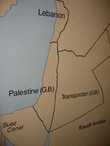
I called up the museum and complained about the what I called Israeli false propaganda there on the map, and the person who answered thanked me and said she would look into it. I have not been back since to see if it was taken down. But as you can clearly see, yes indeed, there was PALESTINE on the map, and I pray to God it will be restored, and once again the Palestinians will be able to live in peace and dignity on THEIR ancestral homeland, safe, secure and sovereign. Note how this Israeli propaganda labels the Palestinian Territory as simply West Bank.
ALSO, please note that the Golan Heights, as shown in the Israeli propagandistic map above, is SYRIAN territory and is ILLEGALLY occupied to this day by Israel, but our mainstream media RARELY ever mentions that. This is why Syria and Israel are enemies to this day.
Oh, but we are supposed to believe that Syria just “hates” Israel because it’s “Jewish”. HA. Hogwash! Stealing land is an ACT OF WAR in any culture.
NO ONE would tolerate some neighbor just stealing their neighbor’s land! How would YOU like it??
ALSO, please note that the Golan Heights, as shown in the Israeli propagandistic map above, is SYRIAN territory and is ILLEGALLY occupied to this day by Israel, but our mainstream media RARELY ever mentions that. This is why Syria and Israel are enemies to this day.
Oh, but we are supposed to believe that Syria just “hates” Israel because it’s “Jewish”. HA. Hogwash! Stealing land is an ACT OF WAR in any culture.
NO ONE would tolerate some neighbor just stealing their neighbor’s land! How would YOU like it??
|
|
The Department of Corrections: Ben-Hur, the LA Times & a place called Palestine
"You know the law - every son of Israel must have some occupation." - Lew Wallace, Ben-Hur: A Tale of the Christ, Chapter IV On September 26, The Los Angeles Times ran a short Calendar section item on the new belated 50th anniversary, fully restored DVD and Blu-Ray editions of William Wyler's 1959 blockbuster biblical epic Ben-Hur. The film, which was based on an 1880 novel by former Civil War general and New Mexico territory governor Lew Wallace, is described by the paper as a "period drama [that] revolves around Judah Ben-Hur (Charlton Heston), a Palestinian nobleman who is enslaved by the Romans, engages |
in one of the most thrilling chariot races ever captured on screen, and even encounters Jesus Christ."
As no innocuous (or factual) mention of "Palestine" goes unpunished, especially when the culprit is a major American publication, the Zionist advocacy group, The Committee for Accuracy in Middle East Reporting in America (CAMERA), was immediately on the case.
The same day the Ben-Hur blurb appeared, CAMERA issued a call to its supporters to contact the Times and complain about its usage of the term "Palestinian nobleman" to describe Ben-Hur's title character, claiming, "Of course, there was no such place as 'Palestine' in the time of Jesus, since the Romans didn't rename Judea as 'Palestina' until a hundred years after the death of Jesus."
Considering CAMERA's supposed interest in "accuracy", it should be noted that its condemnation calls Ben-Hur a "1951 Hollywood blockbuster." In reality, the film was released in November 1959.
Nevertheless, two days later, as a result of CAMERA's complain-campaign, theLA Times printed a correction to its original item. It apologized for referring to Ben-Hur as a "Palestinian nobleman" and continued:
"The character Ben-Hur was a Jew from Judea who lived long before the place now known as Palestine was given that name."
Unfortunately, the paper was far too quick to issue this correction and should have checked some primary sources rather than merely rely on the flurry of emails and phone calls from outraged and misinformed Zionists for their historical information.
To call CAMERA's claim that "there was no such place as 'Palestine' in the time of Jesus" is a matter of revisionism is an understatement. The allegation is not only simply false, it is a deliberate lie.
Specific references to "Palestine" date back nearly five hundred years before "the time of Jesus." In the 5th Century BC, Herodotus, the first historian in Western civilization, referenced "Palestine" numerous times in chronicle of the ancient world, The Histories, including the following passage describing "Syrians of Palestine":
"...they live in the coastal parts of Syria; and that region of Syria and all that lies between it and Egypt is called Palestine." (VII.89)
The above translation by Harry Carter is featured in the 1958 Heritage Press edition of Herodotus' famous work. Both older and newer versions corroborate the accuracy of the reference. A. D. Godley's 1920 translation of the crucial line states, "This part of Syria as far as Egypt is all called Palestine", while Robin Waterfield's 1998 updated Oxford translation renders the passage this way: "This part of Syria, all the way to the border with Egypt, is known as Palestine."
A hundred years later, in the mid-4th Century BC (still nearly four hundred years before the birth of Wallace's fictional hero), Aristotle made reference to the Dead Sea in his Meteorology. "Again if, as is fabled, there is a lake in Palestine, such that if you bind a man or beast and throw it in it floats and does not sink, this would bear out what we have said," he wrote. "They say that this lake is so bitter and salt that no fish live in it and that if you soak clothes in it and shake them it cleans them." (II.3)
Two hundred years later, in the mid-2nd Century BC, ancient geographer Polemon wrote of a place "not far from Arabia in the part of Syria called Palestine," while Greek travel writer Pausanias wrote in his Description of Greece, "In front of the sanctuary grow palm-trees, the fruit of which, though not wholly edible like the dates of Palestine, yet are riper than those of Ionia." (9.19.8)
Despite the claim "the Romans didn't rename Judea as 'Palestina' until a hundred years after the death of Jesus," contemporaries of Jesus also routinely referred to Palestine as, well, Palestine. For instance, in the first decade of the 1st Century, the Roman poet Ovid mentioned Palestine in both his famed mythological poem Metamorphoses and his erotic elegy The Art of Love.
He also wrote of "the waters of Palestine" in his calendrical poem Fasti. Around the same time, another Latin poet Tibullus wrote of "the crowded cities of Palestine" in a section "Messalla’s Triumph" in his poem Delia. Incidentally, Ben-Hur's childhood friend and subsequent betrayer is named Messala.
The bulk of the action of Ben-Hur takes place in the third decade of the 1st Century CE. The noted Alexandrian Jewish philosopher Philo, writing around the very same time, opined, "Also Syria in Palestine, which is occupied by no small part of the very populous nation of the Jews, is not unproductive of honourable virtue." (XII.75)
The Jewish historian Josephus (c.37-100 CE) was born and raised in Jerusalem, a military commander in Galilee during the First Jewish Revolt against the occupying Roman authority, acted as negotiator during the Siege of Jerusalem in 70 CE and later penned vital volumes of Levantine Jewish history. His The Jewish War, Antiquities of the Jews, and Against Apion all contain copious references to Palestine and Palestinians.
Towards the end of Antiquities, Josephus writes,
"I shall now, therefore, make an end here of my Antiquities; after the conclusion of which events, I began to write that account of the war; and these Antiquities contain what hath been delivered down to us from the original creation of man, until the twelfth year of the reign of Nero, as to what hath befallen the Jews, as well in Egypt as in Syria and in Palestine, and what we have suffered from the Assyrians and Babylonians, and what afflictions the Persians and Macedonians, and after them the Romans, have brought upon us; for I think I may say that I have composed this history with sufficient accuracy in all things." (XX.11.2) [emphasis added]
Josephus' own emphasis on accuracy appears to be far more credible than that of CAMERA.
The claim that the Roman emperor Hadrian, eager to punish Jewish inhabitants of Judea after the Bar Kokhba Revolt, officially changed the name of the region to "Syria Palaestina" or simply "Palestine" in 135 CE and forced the Jewish community into exile is dubious at best, especially when, by then, the terms "Syrian Palestine" and "Palestine" had already been in use for over six hundred years.
It should certainly be pointed out that Wallace's original text of Ben-Hur makes no mention of "Palestine" and consistently refers to "Judea", "Judeans", "the land of Israel" and "Israelites." With this in mind, I agree that an appropriate description of the Ben-Hur character would be as a "Judean prince" or even a "Jewish nobleman." Nevertheless, referring to him as a "Palestinian" is not at all inaccurate or incorrect, nor should it be in any way offensive or cause of umbrage.
To lead a charge against such a reference is to promote not only the rewriting of history, both ancient and modern, but also to encourage the continual Zionist efforts to erase, destroy and deny Palestinian history and culture in their own historic homeland.
And yet, the major U.S. newspaper went out of its way to announce that "Ben-Hur was a Jew from Judea who lived long before the place now known as Palestine was given that name," a statement clearly lacking in any semblance of accuracy.
It appears to be time for the Los Angeles Times to issue a correction on their correction.
Nima Shirazi blogs at Wide Asleep in America. You can follow him on Twitter at@wideasleepNima
For Truth, Peace, Justice, Liberty and Equality for All,
As no innocuous (or factual) mention of "Palestine" goes unpunished, especially when the culprit is a major American publication, the Zionist advocacy group, The Committee for Accuracy in Middle East Reporting in America (CAMERA), was immediately on the case.
The same day the Ben-Hur blurb appeared, CAMERA issued a call to its supporters to contact the Times and complain about its usage of the term "Palestinian nobleman" to describe Ben-Hur's title character, claiming, "Of course, there was no such place as 'Palestine' in the time of Jesus, since the Romans didn't rename Judea as 'Palestina' until a hundred years after the death of Jesus."
Considering CAMERA's supposed interest in "accuracy", it should be noted that its condemnation calls Ben-Hur a "1951 Hollywood blockbuster." In reality, the film was released in November 1959.
Nevertheless, two days later, as a result of CAMERA's complain-campaign, theLA Times printed a correction to its original item. It apologized for referring to Ben-Hur as a "Palestinian nobleman" and continued:
"The character Ben-Hur was a Jew from Judea who lived long before the place now known as Palestine was given that name."
Unfortunately, the paper was far too quick to issue this correction and should have checked some primary sources rather than merely rely on the flurry of emails and phone calls from outraged and misinformed Zionists for their historical information.
To call CAMERA's claim that "there was no such place as 'Palestine' in the time of Jesus" is a matter of revisionism is an understatement. The allegation is not only simply false, it is a deliberate lie.
Specific references to "Palestine" date back nearly five hundred years before "the time of Jesus." In the 5th Century BC, Herodotus, the first historian in Western civilization, referenced "Palestine" numerous times in chronicle of the ancient world, The Histories, including the following passage describing "Syrians of Palestine":
"...they live in the coastal parts of Syria; and that region of Syria and all that lies between it and Egypt is called Palestine." (VII.89)
The above translation by Harry Carter is featured in the 1958 Heritage Press edition of Herodotus' famous work. Both older and newer versions corroborate the accuracy of the reference. A. D. Godley's 1920 translation of the crucial line states, "This part of Syria as far as Egypt is all called Palestine", while Robin Waterfield's 1998 updated Oxford translation renders the passage this way: "This part of Syria, all the way to the border with Egypt, is known as Palestine."
A hundred years later, in the mid-4th Century BC (still nearly four hundred years before the birth of Wallace's fictional hero), Aristotle made reference to the Dead Sea in his Meteorology. "Again if, as is fabled, there is a lake in Palestine, such that if you bind a man or beast and throw it in it floats and does not sink, this would bear out what we have said," he wrote. "They say that this lake is so bitter and salt that no fish live in it and that if you soak clothes in it and shake them it cleans them." (II.3)
Two hundred years later, in the mid-2nd Century BC, ancient geographer Polemon wrote of a place "not far from Arabia in the part of Syria called Palestine," while Greek travel writer Pausanias wrote in his Description of Greece, "In front of the sanctuary grow palm-trees, the fruit of which, though not wholly edible like the dates of Palestine, yet are riper than those of Ionia." (9.19.8)
Despite the claim "the Romans didn't rename Judea as 'Palestina' until a hundred years after the death of Jesus," contemporaries of Jesus also routinely referred to Palestine as, well, Palestine. For instance, in the first decade of the 1st Century, the Roman poet Ovid mentioned Palestine in both his famed mythological poem Metamorphoses and his erotic elegy The Art of Love.
He also wrote of "the waters of Palestine" in his calendrical poem Fasti. Around the same time, another Latin poet Tibullus wrote of "the crowded cities of Palestine" in a section "Messalla’s Triumph" in his poem Delia. Incidentally, Ben-Hur's childhood friend and subsequent betrayer is named Messala.
The bulk of the action of Ben-Hur takes place in the third decade of the 1st Century CE. The noted Alexandrian Jewish philosopher Philo, writing around the very same time, opined, "Also Syria in Palestine, which is occupied by no small part of the very populous nation of the Jews, is not unproductive of honourable virtue." (XII.75)
The Jewish historian Josephus (c.37-100 CE) was born and raised in Jerusalem, a military commander in Galilee during the First Jewish Revolt against the occupying Roman authority, acted as negotiator during the Siege of Jerusalem in 70 CE and later penned vital volumes of Levantine Jewish history. His The Jewish War, Antiquities of the Jews, and Against Apion all contain copious references to Palestine and Palestinians.
Towards the end of Antiquities, Josephus writes,
"I shall now, therefore, make an end here of my Antiquities; after the conclusion of which events, I began to write that account of the war; and these Antiquities contain what hath been delivered down to us from the original creation of man, until the twelfth year of the reign of Nero, as to what hath befallen the Jews, as well in Egypt as in Syria and in Palestine, and what we have suffered from the Assyrians and Babylonians, and what afflictions the Persians and Macedonians, and after them the Romans, have brought upon us; for I think I may say that I have composed this history with sufficient accuracy in all things." (XX.11.2) [emphasis added]
Josephus' own emphasis on accuracy appears to be far more credible than that of CAMERA.
The claim that the Roman emperor Hadrian, eager to punish Jewish inhabitants of Judea after the Bar Kokhba Revolt, officially changed the name of the region to "Syria Palaestina" or simply "Palestine" in 135 CE and forced the Jewish community into exile is dubious at best, especially when, by then, the terms "Syrian Palestine" and "Palestine" had already been in use for over six hundred years.
It should certainly be pointed out that Wallace's original text of Ben-Hur makes no mention of "Palestine" and consistently refers to "Judea", "Judeans", "the land of Israel" and "Israelites." With this in mind, I agree that an appropriate description of the Ben-Hur character would be as a "Judean prince" or even a "Jewish nobleman." Nevertheless, referring to him as a "Palestinian" is not at all inaccurate or incorrect, nor should it be in any way offensive or cause of umbrage.
To lead a charge against such a reference is to promote not only the rewriting of history, both ancient and modern, but also to encourage the continual Zionist efforts to erase, destroy and deny Palestinian history and culture in their own historic homeland.
And yet, the major U.S. newspaper went out of its way to announce that "Ben-Hur was a Jew from Judea who lived long before the place now known as Palestine was given that name," a statement clearly lacking in any semblance of accuracy.
It appears to be time for the Los Angeles Times to issue a correction on their correction.
Nima Shirazi blogs at Wide Asleep in America. You can follow him on Twitter at@wideasleepNima
For Truth, Peace, Justice, Liberty and Equality for All,
==============================================================================================================
Zeldzame video van de trein van haifa. Nazareth. Bisan. Tulkarem. Qalqilya. Nablus. Jeruzalem. Lod. Jaffa ' s. Gaza. Daarna van gaza naar arish en caïro in 1930
De trein verschijnt aan het begin als het passeert uit de bossen van west-jeruzalem uit nazareth en voltooit zijn cursus om het centraal station van de stad lod met verschillende afbeeldingen te laten zien.
A rare video of the train (Haifa, Nazareth, Beisan, Tulkarem, Qalqiliya, Nablus, Jerusalem, Lod, Jaffa, Gaza and then from Gaza to Arish and Cairo) in 1930.
The train appears at the beginning, passing through the forests west of Jerusalem from Nazareth and completing its march to show the central station of the city of Lod followed by various pictures
Zeldzame video van de trein van haifa. Nazareth. Bisan. Tulkarem. Qalqilya. Nablus. Jeruzalem. Lod. Jaffa ' s. Gaza. Daarna van gaza naar arish en caïro in 1930
De trein verschijnt aan het begin als het passeert uit de bossen van west-jeruzalem uit nazareth en voltooit zijn cursus om het centraal station van de stad lod met verschillende afbeeldingen te laten zien.
A rare video of the train (Haifa, Nazareth, Beisan, Tulkarem, Qalqiliya, Nablus, Jerusalem, Lod, Jaffa, Gaza and then from Gaza to Arish and Cairo) in 1930.
The train appears at the beginning, passing through the forests west of Jerusalem from Nazareth and completing its march to show the central station of the city of Lod followed by various pictures
